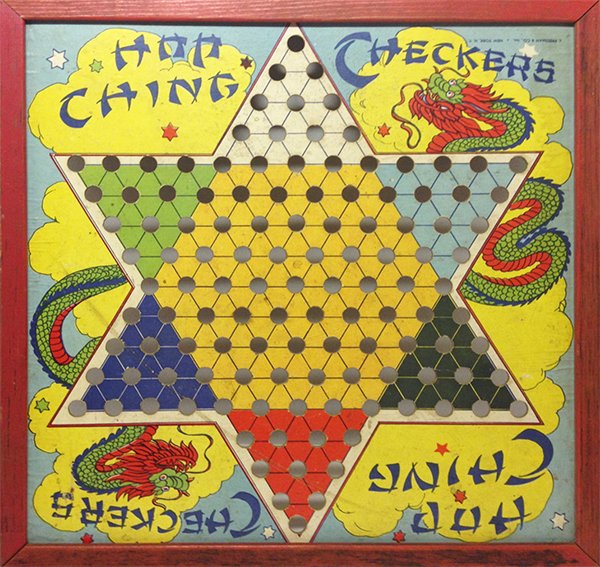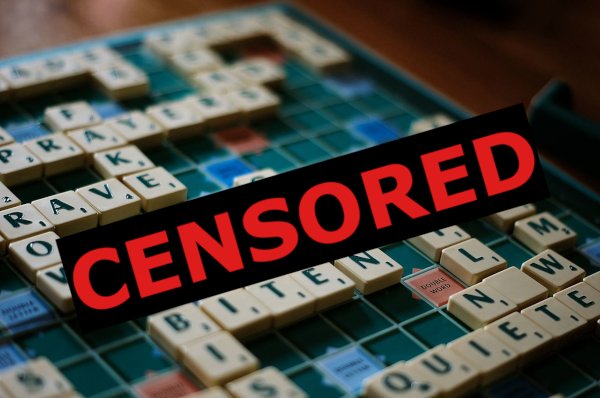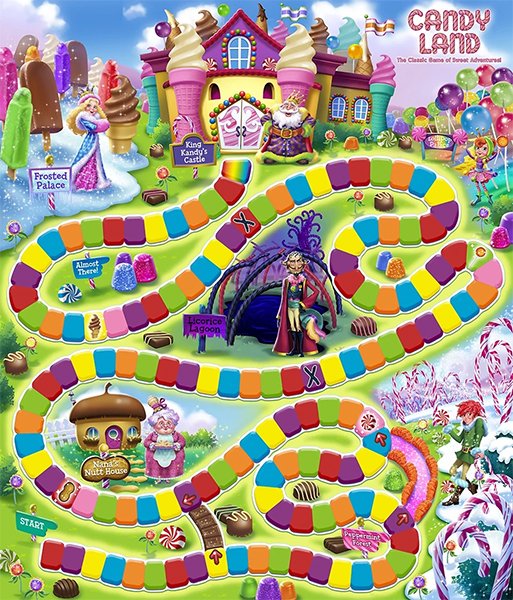5 Board Games With Dark Pasts
Before Netflix and The Modern Rogue, history was a time of darkness and utter boredom. Leisure activities were pretty much limited to waging literal war with foreign powers or playing board games. As such, humanity desperately created millions of board games to distract from the constant stabbing. Unfortunately, despite their promise to be nothing more than fun diversions from death and destruction, many of the most popular and beloved board games come with some pretty dark baggage.
Chinese Checkers Was Made To Capitalize On Americans Thinking Asians Were Weird
Chinese Checkers certainly sounds like a mystical, Far Eastern game, possibly invented by Confucius to teach and delight the minds of ancient peoples. Well, if you think that, you’ve pretty much nailed what the game’s marketers are hoping.
Despite what the name might suggest, Chinese Checkers was actually invented in the 1800s by Germans. The Germans, being a no-nonsense people, named their new game Hoppity because of, you know, the hopping. By 1883, “Hoppity” was changed and renamed “Helma” and more closely resembled the Chinese Checkers we know today. “Helma” was reasonably successful in Britain and other parts of Europe, but the makers of the game decided to sell the game in America. This would require new, clever, and -- because it was intended for American audiences in the 1920s -- kind of racist marketing.
American Checkers just has one hole, and it’s occupied by the richest player.
The roaring ‘20s were an exciting time for Americans. Big band music was on the rise, drinking alcohol was suddenly a sexy, illegal activity, and we’d discovered King Tut’s tomb. Strangely, it was that last little bit that American marketers latched onto, and they renamed Helma “Chinese Checkers” to reflect American’s growing interest in the Far East. And although that sounds incredibly stupid, it totally worked.
Eventually, Milton Bradley bought the rights to the game and stopped prominently displaying racial characters on the box, though they didn’t feel like changing the name to something more accurate like “German Hoppy Pegs.”
The Creator Of Operation Got Shafted
While most of us spent college experimenting with cramming for midterms on seven beers, John Spinello experimented with creating one of the most popular board games of all time: Operation. In 1964, Spinello attended the University of Illinois as an industrial design student. As a class assignment, Spinello was tasked with creating an electric game requiring the player to stick a metal wand into various holes without bumping up against any metal edges. Apparently, the professor was just asking his students to go ahead and invent Operation. Spinello went back to his dorm and invented the game we’ve all played, resulting in one of the most well-deserved As ever given. This would be pretty much the best reward he ever received for Operation.
A family friend of Spinello’s was so pumped about the weird little game he’d made, they found a way to get him a meeting with toy creator Marvin Glass. At the time, Glass was most famous for creating fake puke, so Spinello knew he was the real deal. Glass loved the game and offered Spinello $500 and a nebulous “job offer” once Spinello graduated in exchange for 100% of the rights. Spinello, probably thinking of just how much Coors Lite $500 could buy, agreed to Glass’s lowball offer. He never got his promised job, and it required persistence and multiple phone calls to even get that small cash payout. Considering Operation went on to gross an estimated $40 million, Spinello missed out on more than a few cases of low-carb beer.
Way to support theft from an honest game maker. Scumbags.
In a sad, ironic twist, Spinello was forced in 2014 to raise money for an operation of his own. He required a $25,000 oral surgery, and even with all his skill surgically removing “Writer's Cramps” and “The Ankle Bone Connected to the Knee Bone” Spinello’s operation would require what stuck-up healthcare professionals call a “real surgeon.” Thankfully, he managed to raise the funds, and Hasbro even bought another one of Spinello’s prototypes for potential future use. Maybe they could also give him a job? Or at least a damn craft beer. He deserves one.
Scrabble Had Racist Definitions In Their Dictionary
If we had to guess, most “Scrabble controversies” probably involve somebody trying to pass off “hundo p” as a legitimate play while the other players slap them senseless. But way back in the 1990s, Scrabble courted controversy by offending a Holocaust survivor. Seriously.
Back around the time Salt-N-Pepa were approaching their zenith, two Washington, D.C. women were playing a bit of Scrabble. As so often happens in those games, a suspicious word was played, and the pair turned to the Official Scrabble Player’s Dictionary to settle the issue. During their search, they stumbled across the offensive word “kike.” Both women were upset, and, again, one of them had literally survived the Holocaust. The two looked through the rest of the book to see if there were any other hidden slur-prises. And of course, they found all sorts of offensive words disparaging every minority group imaginable.
The women reached out to Hasbro to complain, but they were essentially told that Scrabble allowed all words as long as they weren’t proper nouns. “Dave” is too much, but the N-word is always fair game! They eventually turned to the Anti-Defamation League to help their case.
“That last word made Mom full-on puke.”
The ADL was immediately on board. They contacted Hasbro, and sparked a crazy back and forth debate over what words would be considered acceptable for the official dictionary. Although most of the racial slurs were quickly removed, the women wanted words like d**k, f****t, b***h, etc. taken out, but they were all left in because they have multiple meanings. The more vulgar definitions were removed, however. For example, the dictionary had “to bargain with” as an example for “Jew” which is more than a little offensive.
Ultimately, Hasbro removed around 200 words for the next edition of the dictionary, although today the official list now includes words like “grrl,” “thang,” and “blingy.” So ... there’s that. Also, though they’re still not in the dictionary, racial slurs were reintroduced for official tournament play. Presumably because an official multiplayer game without the use of slurs would be unrecognizable.
Twister Was Considered Far Too Sexual, Until They Made Sexuality The Whole Point
These days Twister is best known as the game that finally blew out Grandpa’s hip during your fifth birthday party. When it was invented, however, Americans saw it much differently than the benign family game it is now. Back in the ‘60s, Twister was accused of being pure, unadulterated “sex in a box.” Apparently, sex used to be highly regimented and colorful.
In 1965, a man named Reyn Guyer was hired to sell some back-to-school shoes. He created a polka dot mat to highlight the children’s footwear, but quickly realized that he could also step on it. The resulting game was given the creepiest possible name, King’s Footsie, and pitched to game makers. No dice. Guyer then hired some game designers who rebranded the game Pretzel, then Twister, and eventually attracted the attention of Milton Bradley, who helped the game sell ... almost no copies.
For the first few months, sales were terrible. Sears refused to carry it in its popular catalog, believing the game to be inappropriate, and even several Milton Bradley execs felt like they were peddling some form of smut. In a final effort to save Twister, the PR company in charge of selling the game asked the Tonight Show if Johnny Carson would consider trying it during an episode.
Carson agreed, and he and sex-in-a-dress symbol, Eva Gabor, played it on the air. Sales went through the freaking roof. The creator of the game claims that its eventual success was actually because of its overwhelming sexuality. “People had not up to that point been granted the possibility of being that close and enjoying it in a group setting.”
Next time your cousins suggest a rousing game of Twister, feel free to remind them that the only reason anybody’s even heard of Twister is because of its latent sexuality. Or don’t tell them. We’re not here to judge.
Candy Land Was Made For Children With Polio
Candy Land is the quintessential kids’ game. It’s bright, colorful, quick to learn, and is especially easy to play for small children stricken with polio. Does that last tidbit feel forced? Well, playability for polio sufferers is pretty much the whole reason we have Candy Land in the first place.
In 1948, retired schoolteacher Eleanor Abbot was stuck in a hospital, suffering from polio. All day, she’d sit there and stare at the sad, lonely kids who also had polio, but had nothing to do. To cure everybody’s boredom, Abbot decided to come up with a fun board game. She needed it to be simple enough for young kids to play and cheery enough to distract from, you know, the polio. Candy Land ended up being perfect for kids because it required no counting, no reading, and was all about freaking candy.
The loser has to eat the board.
Milton Bradley bought the game just a year later, and it ended up becoming a huge hit for them. Unsurprisingly, the company kept the game’s polio-riddled roots under wraps for a long, long time, but according to some sources, Candy Land’s polio connection didn’t stop with its creation.
The 1950s saw a massive outbreak of polio that terrified everybody in America. The only way to be sure you didn’t catch the disease was to stay inside and avoid people entirely. Parents were loathe to let their children go anywhere, so a lot of kids ended up staying inside more than they usually would. And since it’d be another 50 years before anybody got around to inventing Super Smash Bros., kids were forced to turn to board games for enjoyment. And wouldn’t you know, one of the most popular up and coming games at the time just so happened to be Candy Land. It’s almost like King Kandy himself staged an outbreak ... of happiness!









